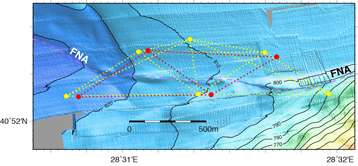An innovative technique for monitoring submarine faults

To monitor a segment of the North Anatolian seismic fault near Istanbul, an international team of researchers, in particular from CNRS and Université de Bretagne Occidentale, has installed a network of transponders on the floor of the Sea of Marmara. The aim is to measure motion of the sea floor on either side of this segment. The data collected during the first six months reveals that the fault is probably locked in the region of this segment, suggesting that there is a progressive build-up of energy that could be released suddenly. This could cause a major earthquake in the Istanbul area. The study, carried out by a collaboration of researchers from France, Germany and Turkey, is published in Geophysical Research Letters .
The North Anatolian fault, which caused destructive earthquakes in Turkey in 1999, is comparable to the San Andreas fault in California. It marks the boundary between the Eurasian and Anatolian tectonic plates, which move relative to each other at a speed of around 2 cm per year. The behavior of one underwater segment of the fault, located a few tens of kilometers from Istanbul in the Sea of Marmara, particularly intrigues researchers, since there has apparently been no seismic activity there since the eighteenth century. How does this segment behave? Does it continuously creep? Does it regularly give way, occasionally causing small, low-magnitude quakes? Or is it locked, making it likely that it will one day rupture and cause a major earthquake?
Observing the motion of a submarine fault in situ over a period of several years is no easy matter. To meet this challenge, the researchers are testing an innovative underwater remote sensing method, using active, autonomous acoustic transponders remotely accessible from the sea surface. Placed on the sea floor on either side of the fault at a depth of 800 meters, the transponders take it in turns to interrogate each other in pairs, and measure the round-trip time of an acoustic signal between them. These time lapses are then converted into distances between the transponders. The variation in these distances over time is used to detect motion of the sea floor and any deformation of the network of transponders, and thus infer the displacement of the fault. Specifically, a network of ten French and German transponders was set up during an initial sea cruise in October 2014. The first six months of data (travel time, temperature, pressure and stability) have confirmed that the system is performing well. Following calculations, the data show no significant motion of the monitored fault, within the network's resolution limits. The distances between the transponders, which are between 350 and 1700 meters apart, are measured with a resolution of 1.5 to 2.5 mm. The segment is therefore probably locked or nearly locked, and is accumulating stress that could trigger an earthquake. However, it will be necessary to acquire data for several years in order to confirm this observation or show that this part of the fault has a more complex behavior.
Going beyond this specific demonstration, if this approach, known as acoustic seafloor geodesy, proves to be robust in the long term (in this case, three to five years are planned, within the limits of the autonomy of the batteries), it could be included within a permanent underwater observatory as an addition to other observations (seismology, gas bubble emission, etc) for in situ real-time monitoring of the activity of this particular fault, or of other active submarine faults elsewhere in the world.

More information: P. Sakic et al. No significant steady state surface creep along the North Anatolian Fault offshore Istanbul: Results of 6 months of seafloor acoustic ranging, Geophysical Research Letters (2016). DOI: 10.1002/2016GL069600
Journal information: Geophysical Research Letters
Provided by CNRS

















